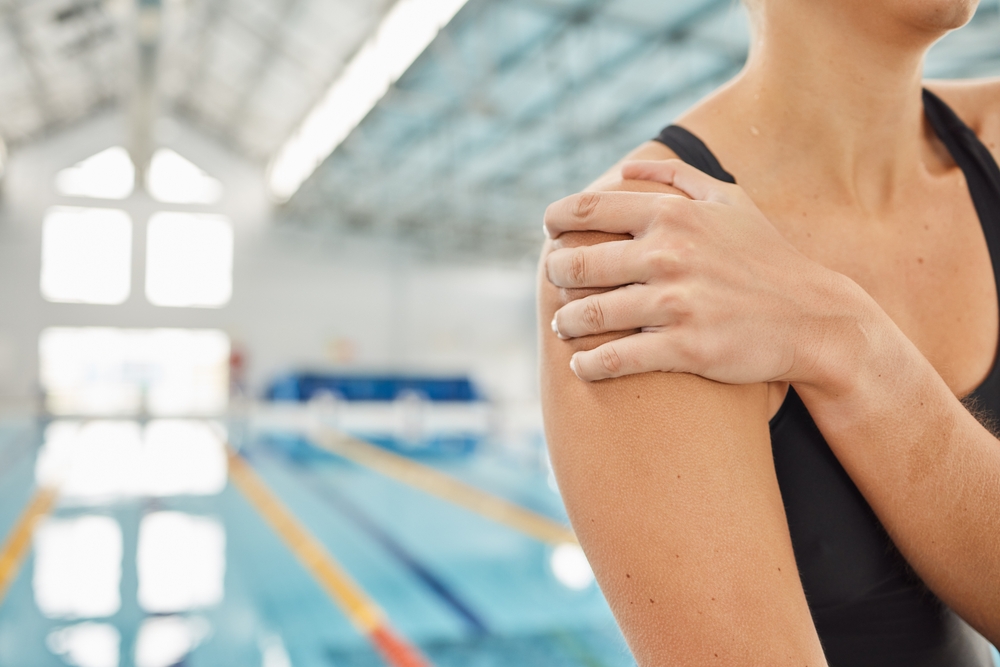As many as 9 in 10 competitive swimmers aged 13 to 25 years report shoulder pain. This is primarily due to high training loads and the repetitive nature of the sport. However, if you are a competitive swimmer, you don’t have to suffer from shoulder pain. This article reveals 5 simple exercises for swimmers to bulletproof their shoulders.
Exercises Proven To Reduce Shoulder Injury Risk in Swimmers
According to the latest research, there are 2 modifiable injury risk factors in competitive swimmers. The largest amount of research suggests greater injury risk in swimmers with poor strength and endurance of the rotator cuff and shoulder blade muscles. Also, acute spikes in swimming workloads increase injury risk in swimmers.
A 2024 study in the International Journal of Sports Physical Therapy investigated the effects of preventative shoulder strengthening exercises in high school and college swimmers. Twelve of the 31 swimmers studied reported shoulder pain at the start of the study. After one year of performing a basic strengthening and stretching program twice per week, 10 of the 12 athletes were pain-free.
The Importance of the Posterior Shoulder Muscles in Swimmers

The posterior shoulder musculature consists of the scapular stabilizers (trapezius and serratus anterior) and the external rotators of the rotator cuff (supraspinatus and teres minor). Poor endurance and low activity of these muscles during the crawl and backstroke are associated with shoulder pain in swimmers. Therefore a regular exercise program targeting endurance of the posterior shoulder is crucial for any competitive swimmer. We recommend the following 5 exercises be done for 3 sets of 12 to 20 repetitions at least 3 days per week.
Prone Row
Begin on your stomach holding a dumbbell. Starting with your arm in an extended position, perform a row. Keep your elbow close but not against the side of your body. Hold the top position for 1-2 seconds before slowly lowering the weight. It is important to pull the shoulder blade back as you raise your elbow. Avoid overextending and shrugging your shoulders.
Prone Lower Trap Raises
This exercise strengthens all parts of your trapezius. Lie face down with one arm over the side of a table or bench. Keep your neck in a relaxed neutral position resting on your other forearm. With your thumb up and arm straight lift toward the ceiling at a 45-degree angle from your head (the 10:00 and 2:00 positions of a clock). This position is aligned with the muscle fibers of your lower trapezius.
Be careful to avoid shrugging your shoulder as you raise your arm. Instead, think about tilting the shoulder blade backward as you raise your arm. Pause at the top of the movement before returning to the start position in a controlled manner.
Side-lying External Rotation
Lie on your side holding a dumbbell with your elbow bent. Place a towel roll in the armpit to increase activation of your rotator cuff. Rotate your arm upwards maintaining the elbow against the side of your body. Hold the top position for 1-2 seconds before slowly lowering the weight. Also, pull your shoulder blade back as you raise your arm. This increases activation of the middle and lower trapezius muscles.
Side-lying Shoulder Flexion
This exercise targets your trapezius and rotator cuff. Perform shoulder flexion raises in a side-lying position to minimize biceps activity and reduce strain on your labrum. Start on your side holding a light dumbbell. Keep your elbow straight as you raise your arm slightly overhead. Keep your arm parallel to the floor as you perform the movement.
Serratus Wall Walks
Wrap a resistance band around your wrists and pull it apart. Keep your forearms parallel and take the form of the number “11” throughout the exercise. Protract the shoulder blades by pushing your upper back away from the wall to activate your serratus anterior. Then, “walk” your forearms up the wall in a controlled manner to approximately eye level or slightly higher. Make sure you don’t lose protraction. Return to the starting point in a controlled manner and repeat for the desired number of repetitions.
See Your Physical Therapist for a Personalized Exercise Program
These 5 simple exercises can easily be done at home with minimal equipment. All you need is an elastic band and a few light dumbbells. Ideally, swimmers should perform shoulder muscle exercises year-round throughout their careers. Committed athletes who are proactive with their exercise program will benefit from reduced injury risk and improved performance.
If you want more help developing an exercise program for success in the pool, call our office to schedule an initial evaluation. The doctors of physical therapy at BSR have been helping people move without pain since 2007. We are always here to help when you need us.

